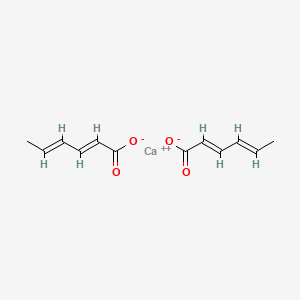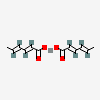Calcium sorbate
- CALCIUM SORBATE
- 7492-55-9
- calcium (2E,4E)-hexa-2,4-dienoate
- Calcium dihexa-2,4-dienoate
- Sorbic acid, calcium salt
- Create:2006-04-28
- Modify:2025-01-18

- CALCIUM SORBATE
- 7492-55-9
- calcium (2E,4E)-hexa-2,4-dienoate
- Calcium dihexa-2,4-dienoate
- Sorbic acid, calcium salt
- Calcium (2E4E)-hexa-24-dienoate
- 2,4-Hexadienoic acid, calcium salt
- HSDB 587
- Sorbic Acid Calcium Salt
- UNII-2P47R6817F
- EINECS 231-321-6
- Calcium 2,4-hexadienoate, (E,E)-
- 2P47R6817F
- CALCIUM SORBATE [FCC]
- CALCIUM SORBATE [HSDB]
- INS NO.203
- 2,4-Hexadienoic acid, calcium salt, (E,E)-
- INS-203
- SORBIC ACID CALCIUM SALT [MI]
- 2,4-Hexadienoic acid, calcium salt (2:1), (2E,4E)-
- E-203
- 2,4-Hexadienoic acid, calcium salt, (2E,4E)-
- C12H14CaO4
- calcium bis((2E,4E)-hexa-2,4-dienoate)
- SCHEMBL146359
- CALCIUM SORBATE [INCI]
- DTXSID2052491
- MCFVRESNTICQSJ-RJNTXXOISA-L
- Calcium 2,4hexadienoate, (E,E)
- 2,4Hexadienoic acid, calcium salt
- AKOS015836366
- calcium;(2E,4E)-hexa-2,4-dienoate
- GS-3343
- Calcium di[(2E,4E)-2,4-hexadienoate]
- 2,4Hexadienoic acid, calcium salt, (E,E)
- CS-0158288
- S0054
- D92224
- Q425183
- W-104406
- Calcium (2E pound not4E)-hexa-2 pound not4-dienoate
 Green circle - The chemical has been verified to be of low concern
Green circle - The chemical has been verified to be of low concernNot Classified
Reported as not meeting GHS hazard criteria by 58 of 59 companies (only 1.7% companies provided GHS information). For more detailed information, please visit ECHA C&L website.
Aggregated GHS information provided per 59 reports by companies from 2 notifications to the ECHA C&L Inventory.
Reported as not meeting GHS hazard criteria per 58 of 59 reports by companies. For more detailed information, please visit ECHA C&L website.
There is 1 notification provided by 1 of 59 reports by companies with hazard statement code(s).
Information may vary between notifications depending on impurities, additives, and other factors. The percentage value in parenthesis indicates the notified classification ratio from companies that provide hazard codes. Only hazard codes with percentage values above 10% are shown.
Chemical: Calcium sorbate

IMAP assessments - 2,4-Hexadienoic acid, calcium salt, (E,E)-: Human health tier I assessment
IMAP assessments - 2,4-Hexadienoic acid, calcium salt, (E,E)-: Environment tier I assessment
- Australian Industrial Chemicals Introduction Scheme (AICIS)2,4-Hexadienoic acid, calcium salt, (E,E)-https://services.industrialchemicals.gov.au/search-assessments/2,4-Hexadienoic acid, calcium salt, (E,E)-https://services.industrialchemicals.gov.au/search-inventory/
- ChemIDplusChemIDplus Chemical Information Classificationhttps://pubchem.ncbi.nlm.nih.gov/source/ChemIDplus
- EPA Chemicals under the TSCA2,4-Hexadienoic acid, calcium salt (2:1), (2E,4E)-https://www.epa.gov/chemicals-under-tscaEPA TSCA Classificationhttps://www.epa.gov/tsca-inventory
- EPA DSSToxCalcium di[(2E,4E)-2,4-hexadienoate]https://comptox.epa.gov/dashboard/DTXSID2052491CompTox Chemicals Dashboard Chemical Listshttps://comptox.epa.gov/dashboard/chemical-lists/
- European Chemicals Agency (ECHA)LICENSEUse of the information, documents and data from the ECHA website is subject to the terms and conditions of this Legal Notice, and subject to other binding limitations provided for under applicable law, the information, documents and data made available on the ECHA website may be reproduced, distributed and/or used, totally or in part, for non-commercial purposes provided that ECHA is acknowledged as the source: "Source: European Chemicals Agency, http://echa.europa.eu/". Such acknowledgement must be included in each copy of the material. ECHA permits and encourages organisations and individuals to create links to the ECHA website under the following cumulative conditions: Links can only be made to webpages that provide a link to the Legal Notice page.https://echa.europa.eu/web/guest/legal-noticeCalcium dihexa-2,4-dienoatehttps://echa.europa.eu/substance-information/-/substanceinfo/100.028.474Calcium dihexa-2,4-dienoate (EC: 231-321-6)https://echa.europa.eu/information-on-chemicals/cl-inventory-database/-/discli/details/62083
- FDA Global Substance Registration System (GSRS)LICENSEUnless otherwise noted, the contents of the FDA website (www.fda.gov), both text and graphics, are not copyrighted. They are in the public domain and may be republished, reprinted and otherwise used freely by anyone without the need to obtain permission from FDA. Credit to the U.S. Food and Drug Administration as the source is appreciated but not required.https://www.fda.gov/about-fda/about-website/website-policies#linking
- Hazardous Substances Data Bank (HSDB)CALCIUM SORBATEhttps://pubchem.ncbi.nlm.nih.gov/source/hsdb/587
- EPA Chemical and Products Database (CPDat)Calcium di[(2E,4E)-2,4-hexadienoate]https://comptox.epa.gov/dashboard/DTXSID2052491#exposureEPA CPDat Classificationhttps://www.epa.gov/chemical-research/chemical-and-products-database-cpdat
- Haz-Map, Information on Hazardous Chemicals and Occupational DiseasesLICENSECopyright (c) 2022 Haz-Map(R). All rights reserved. Unless otherwise indicated, all materials from Haz-Map are copyrighted by Haz-Map(R). No part of these materials, either text or image may be used for any purpose other than for personal use. Therefore, reproduction, modification, storage in a retrieval system or retransmission, in any form or by any means, electronic, mechanical or otherwise, for reasons other than personal use, is strictly prohibited without prior written permission.https://haz-map.com/AboutCalcium sorbatehttps://haz-map.com/Agents/4178
- EPA Safer ChoiceCalcium sorbatehttps://www.epa.gov/saferchoice/safer-ingredientsEPA Safer Chemical Ingredients Classificationhttps://www.epa.gov/saferchoice
- EU Food Improvement AgentsCALCIUM SORBATEhttp://data.europa.eu/eli/reg/2012/231/2024-04-23
- Joint FAO/WHO Expert Committee on Food Additives (JECFA)LICENSEPermission from WHO is not required for the use of WHO materials issued under the Creative Commons Attribution-NonCommercial-ShareAlike 3.0 Intergovernmental Organization (CC BY-NC-SA 3.0 IGO) licence.https://www.who.int/about/policies/publishing/copyright
- NORMAN Suspect List ExchangeLICENSEData: CC-BY 4.0; Code (hosted by ECI, LCSB): Artistic-2.0https://creativecommons.org/licenses/by/4.0/NORMAN Suspect List Exchange Classificationhttps://www.norman-network.com/nds/SLE/
- FDA Substances Added to FoodLICENSEUnless otherwise noted, the contents of the FDA website (www.fda.gov), both text and graphics, are not copyrighted. They are in the public domain and may be republished, reprinted and otherwise used freely by anyone without the need to obtain permission from FDA. Credit to the U.S. Food and Drug Administration as the source is appreciated but not required.https://www.fda.gov/about-fda/about-website/website-policies#linking
- Human Metabolome Database (HMDB)LICENSEHMDB is offered to the public as a freely available resource. Use and re-distribution of the data, in whole or in part, for commercial purposes requires explicit permission of the authors and explicit acknowledgment of the source material (HMDB) and the original publication (see the HMDB citing page). We ask that users who download significant portions of the database cite the HMDB paper in any resulting publications.http://www.hmdb.ca/citingCalcium sorbatehttp://www.hmdb.ca/metabolites/HMDB0303727
- Japan Chemical Substance Dictionary (Nikkaji)
- SpectraBaseSORBIC ACID, CALCIUM SALThttps://spectrabase.com/spectrum/4UvLVrXAmyVsorbic acid, calcium salthttps://spectrabase.com/spectrum/KGpkBPVEUf7
- Wikidatacalcium sorbatehttps://www.wikidata.org/wiki/Q425183
- WikipediaCalcium benzoatehttps://en.wikipedia.org/wiki/Calcium_benzoateCalcium sorbatehttps://en.wikipedia.org/wiki/Calcium_sorbate
- PubChem
- GHS Classification (UNECE)GHS Classification Treehttp://www.unece.org/trans/danger/publi/ghs/ghs_welcome_e.html
- MolGenieMolGenie Organic Chemistry Ontologyhttps://github.com/MolGenie/ontology/


 CID 643460 (Sorbic Acid)
CID 643460 (Sorbic Acid) CID 5460341 (Calcium)
CID 5460341 (Calcium)